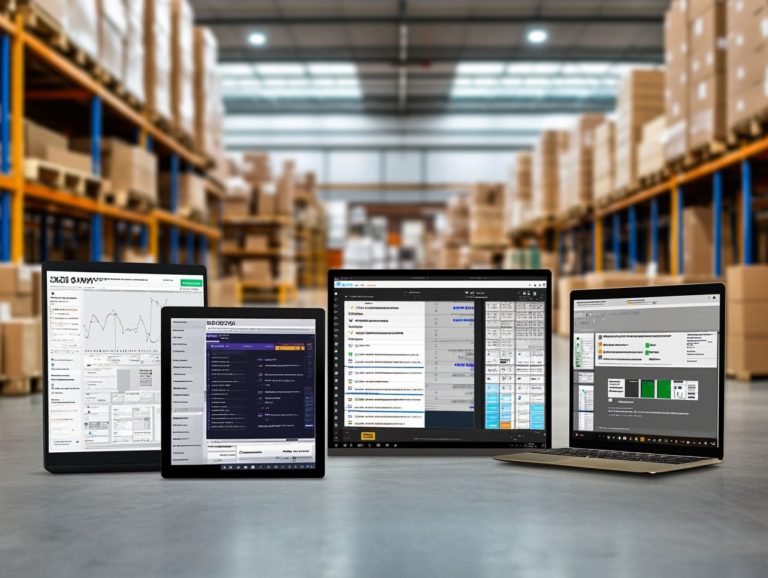How SaaS Improves Communication in Teams
Effective communication is the backbone of successful teams. It shapes collaboration, boosts productivity, and elevates overall morale.
As organizations embrace Software as a Service (SaaS), enhanced communication becomes even clearer.
This article discusses the importance of effective communication in teams. It offers insights into SaaS and its features designed to streamline interactions.
You’ll find popular tools, implementation strategies, success metrics, and common challenges. This guide aims to transform team communication through SaaS.
Contents
- Key Takeaways:
- The Importance of Effective Communication in Teams
- What is SaaS?
- How SaaS Can Improve Team Communication
- Examples of SaaS Tools for Team Communication
- Implementing SaaS for Team Communication
- Measuring the Impact of SaaS on Team Communication
- Potential Challenges and Solutions
- Frequently Asked Questions
- How does SaaS improve communication in teams?
- What are some specific ways that SaaS can enhance team communication?
- How does SaaS improve communication between remote team members?
- Can SaaS help improve communication within different teams?
- How does SaaS address communication challenges within teams?
- How can SaaS improve transparency and accountability within teams?
Key Takeaways:

Effective communication is crucial for team success. It fosters collaboration, trust, and productivity.
SaaS provides features like real-time messaging and project management tools that can greatly enhance communication.
To implement SaaS effectively, choose the right tools, train your team, and measure impact with relevant metrics.
The Importance of Effective Communication in Teams
Effective communication is the cornerstone of successful teamwork, especially in today s workplace, where remote work and integrated tools are essential.
By ensuring that every team member feels heard and valued, you create an environment where everyone feels safe to share their ideas. This is vital for boosting employee engagement and productivity.
In a landscape increasingly shaped by business-to-business (B2B) SaaS solutions, your ability to communicate effectively goes beyond simple conversation. It involves leveraging advanced collaboration tools that meet the modern demands of virtual interaction.
Why Communication is Crucial for Team Success
Effective communication stands as a cornerstone for your team’s success. It directly shapes employee satisfaction and ultimately influences the customer experience.
When you and your team engage in open dialogues, you cultivate a culture of collaboration that elevates project outcomes. For example, regular check-ins can help you identify potential issues early on, allowing your team to address them swiftly before they escalate into larger problems.
Effective communication is essential for resolving conflicts. By fostering transparent discussions, you can clarify misunderstandings, leading to a more cohesive work environment. This positive atmosphere enhances morale and translates into improved customer interactions.
When employees feel supported and valued, they are far more inclined to deliver exceptional service, ensuring that clients leave feeling satisfied and engaged.
What is SaaS?
Software as a Service (SaaS) represents an innovative software model that you access over the internet. This spares you from the burdensome tasks of extensive hardware and software installation.
As a business-to-business (B2B) SaaS solution, this model has transformed software development by boosting scalability, reducing costs, and enhancing user accessibility.
You can effortlessly integrate a variety of productivity tools into your workflows, ultimately elevating team communication and collaboration to new heights.
Definition and Explanation
SaaS, or Software as a Service, represents a cutting-edge method of software delivery where applications reside in the cloud and are easily accessed via the internet.
This innovative approach negates the need for local installations, giving you the power to access essential tools from any device connected to the web. By embracing cloud computing, you can streamline operations while offering your employees the flexibility they crave to work remotely.
The advantages of SaaS go well beyond mere convenience. It provides cost efficiency by alleviating the IT burden related to maintenance and upgrades. This model creates exciting opportunities for teamwork, enabling team members to collaborate in real time, no matter where they are.
SaaS not only boosts productivity but also meets the modern workforce s increasing demand for agile and accessible solutions.
How SaaS Can Improve Team Communication

SaaS (Software as a Service) solutions have the power to elevate your team’s communication by offering integrated tools crafted specifically to enhance collaboration and streamline workflows. This ultimately drives productivity to new heights.
These cloud-based tools empower your team to communicate in real-time, organize tasks seamlessly, and manage projects with remarkable efficiency. This creates an environment where everyone is aligned and actively engaged.
The automated systems in SaaS platforms greatly reduce manual effort, letting your team focus on important tasks.
Features and Benefits of SaaS for Teams
The features of SaaS platforms include real-time collaboration tools, integrated communication channels, and task management systems. These offer a wealth of benefits that elevate your team’s productivity.
Use chatbots and engagement tools to simplify workflows. This helps minimize delays. These platforms make communication a breeze, allowing you and your team members to share updates and feedback in real time, fostering a culture of transparency and collaboration.
With automated reminders and task assignments integrated into your workflow, you can maintain organization and ensure that deadlines are met without the chaos of missed notifications.
Ultimately, these features let you focus on what really matters, boosting efficiency and performance.
Examples of SaaS Tools for Team Communication
Numerous SaaS tools have risen to prominence in enhancing team communication and collaboration, each presenting distinct features designed to cater to various organizational needs.
Prominent examples include:
- Trengo for integrated messaging
- Slack for fostering team collaboration
- Microsoft Teams for seamless virtual meetings
- HubSpot for efficient customer relationship management
- Trello for streamlined task organization
These tools empower remote teams to communicate with greater efficacy, significantly boosting their overall productivity.
Popular and Effective SaaS Options
Popular SaaS options like Slack, Microsoft Teams, and Trengo enhance team communication through their ability to elevate collaboration efforts.
These platforms offer a variety of features designed to enhance your workflow and streamline conversations among team members.
For example, Slack shines with its intuitive channels. This allows you to segment discussions by projects or topics, promoting a more organized style of communication. Meanwhile, Microsoft Teams integrates seamlessly with Office 365, making file sharing and real-time document collaboration a breeze, which can significantly boost your productivity.
Trengo takes a different approach, specializing in customer interactions by providing a unified inbox for messages from multiple platforms. This ensures your team can respond quickly and effectively.
Each of these tools plays a vital role in nurturing a healthier communication dynamic within your team, ultimately leading to improved collaboration and greater overall effectiveness.
Implementing SaaS for Team Communication
Implementing SaaS for team communication requires thoughtful planning and precise execution to achieve a seamless integration with your existing workflows and systems.
It s essential to assess your specific communication needs and select the appropriate tools that align with your objectives, whether that s boosting cooperative efforts or productivity.
By adhering to best practices, you can significantly streamline the adoption process, resulting in a more engaged and effective team.
Ready to transform your team’s communication? Explore these tools today!
Steps for Successful Implementation

Successful implementation of SaaS, or Software as a Service, tools for team communication hinges on several critical steps. These include assessing your team s needs, selecting the most appropriate tools, and providing training and support. These foundational elements pave the way for effective collaboration and heightened productivity.
- First, take the time to understand the unique dynamics and communication styles within your team. This insight will guide you in choosing the software that fits best.
- Next, involve every team member in the decision-making process. Their insights and preferences are invaluable and will foster a greater sense of ownership and buy-in.
- Once you ve selected a tool, prioritize thorough training sessions tailored to various skill levels. This ensures that everyone feels confident and capable of using the new software.
- Establish a feedback loop where team members can share their experiences and challenges. This practice not only encourages open communication but also cultivates a culture of continuous improvement and adaptability.
Measuring the Impact of SaaS on Team Communication
Measuring the impact of SaaS on team communication is vital for grasping its effectiveness and identifying areas for enhancement. By analyzing specific metrics related to team performance, productivity, and customer satisfaction, you can uncover valuable insights into how well your communication strategies align with your organizational goals.
Essential metrics to consider include:
- Response times
- Task completion rates
- Levels of team engagement
This approach will empower you to refine your strategies and drive meaningful improvements in your team’s communication dynamics.
Metrics to Track and Analyze
When analyzing the impact of SaaS tools on team communication, there are critical metrics you should keep an eye on think productivity rates, team satisfaction surveys, and engagement levels.
Understanding productivity rates is key; they reveal how effectively team members are leveraging these tools to meet their goals. You can measure this through output metrics, such as project completion timelines and adherence to deadlines.
Team satisfaction surveys provide qualitative insights, allowing you to gauge whether the tools are enhancing or hindering the work environment. Engagement levels can be tracked through usage frequency and interaction metrics, highlighting potential areas for improvement in communication.
By examining these metrics together, you’ll uncover valuable insights into team dynamics and the overall effectiveness of your communication strategies. This paves the way for enhanced collaboration and performance.
Potential Challenges and Solutions
Implementing SaaS tools for team communication can bring a wealth of benefits, but it’s essential to be aware of the potential challenges that may arise. Common obstacles include resistance to change, integration issues with existing systems, and ensuring user adoption is crucial.
By identifying these challenges early, you can develop tailored solutions that significantly enhance the effectiveness of your communication strategies.
Addressing Common Obstacles in SaaS Adoption
Addressing common obstacles in SaaS adoption is vital for ensuring a seamless transition and unlocking the full potential of new communication tools. You may encounter challenges such as resistance to change, insufficient training, and integration issues with your existing systems.
Resistance often arises from employees’ attachment to familiar processes. Foster team engagement through clear communication about the benefits and actively involve team members in the transition plan. This can significantly ease their apprehensions.
By offering thorough training sessions tailored to different skill levels, you can empower your workforce to confidently utilize the new tools. Tackling integration concerns early on, with the involvement of IT specialists, ensures seamless compatibility with legacy systems, thereby enhancing the user experience and overall satisfaction.
Through collective effort and a commitment to involving your team, you can effectively manage these barriers and pave the way for successful adoption.
Frequently Asked Questions

How does SaaS improve communication in teams?
SaaS, or Software as a Service, offers tools for efficient communication among team members. These tools enable real-time messaging, file sharing, and project management.
What are some specific ways that SaaS can enhance team communication?
SaaS features centralized communication channels and task tracking. These streamline communication and improve collaboration.
How does SaaS improve communication between remote team members?
Remote team members can easily connect through online platforms. This helps eliminate communication barriers caused by physical distance.
Can SaaS help improve communication within different teams?
Yes, SaaS tools help departments communicate effectively. They provide a platform to break down silos and enhance collaboration.
How does SaaS address communication challenges within teams?
SaaS tools tackle common issues like language barriers and time differences. They help teams communicate more effectively.
How can SaaS improve transparency and accountability within teams?
SaaS platforms offer project management features for task assignment and progress tracking. This ensures everyone is aware of their team’s progress.
Start using SaaS today to transform your team’s communication!






